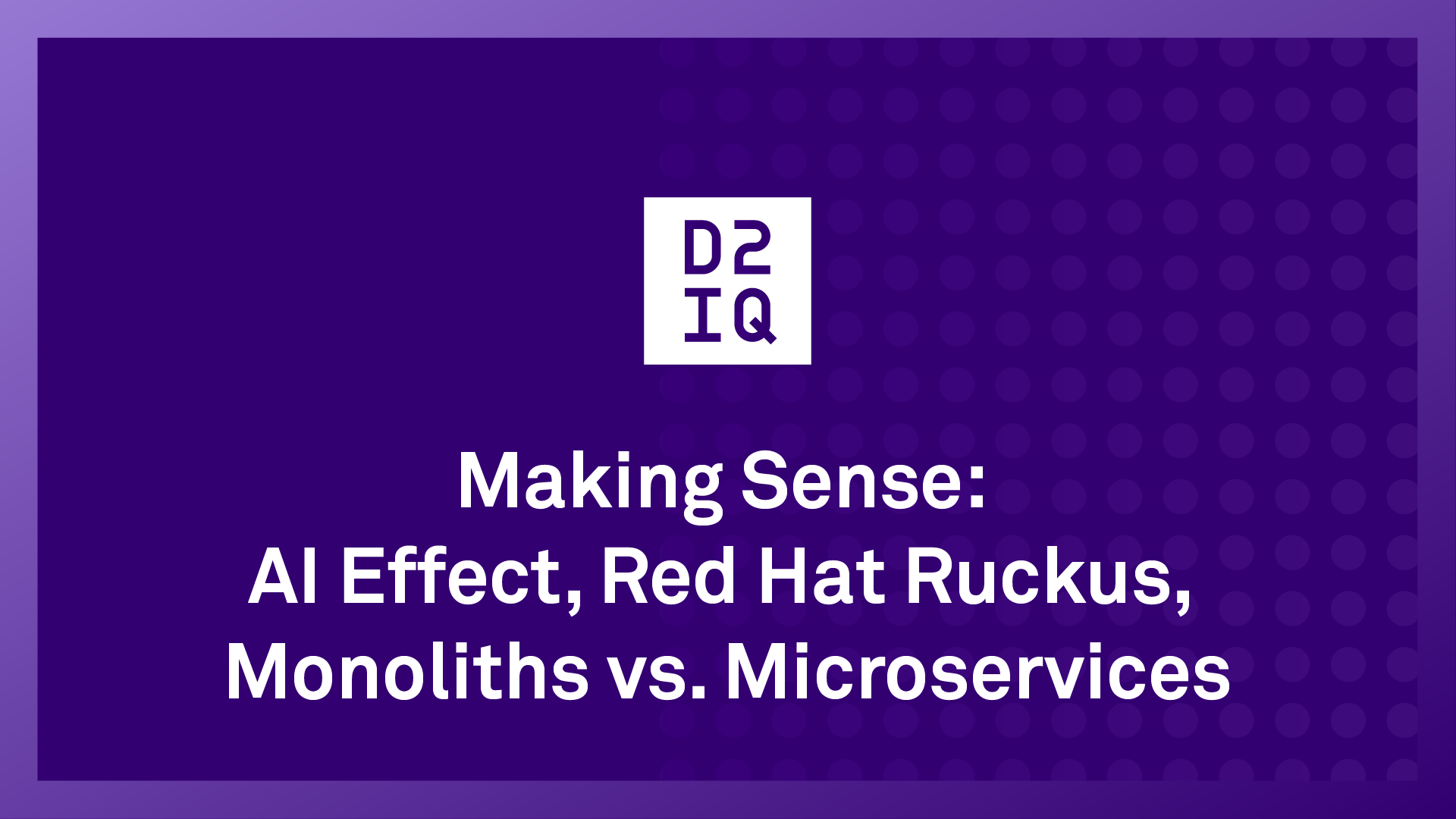Making Sense: AI Effect, Red Hat Ruckus, Monoliths vs. Microservices

5 min read
Each day the news assails us with a jumbled wave of trends, hype, provocative claims, and skirmishes. From news venues around the globe, the D2iQ brain trust is called upon to provide insights and commentary to help make sense of the hot topics and controversies affecting the cloud-native and Kubernetes communities.

AI Appreciated
Most recently, D2iQ CEO Tobi Knaup shared his views on the benefits of the intelligent infrastructure that is made possible through the convergence of cloud, Kubernetes, and AI. A VMBlog report on AI Appreciation included this commentary by Tobi:
"The convergence of cloud, Kubernetes, and AI has given birth to next-generation intelligent infrastructure. An intelligent IT infrastructure powered by AI is the ideal platform for enabling AI workloads and unleashing innovation as it frees development teams' mundane and time-intensive infrastructure maintenance, allowing them to focus on the higher-value activities that spur true innovation. Besides, within an intelligent infrastructure, helpers like AI-driven chatbots and insights engines can also provide expert advice, troubleshooting, performance optimization, automated workflows, etc.”
“Another thing that AI is appreciated is how it can help companies to reduce costs and fill the skills gap. I believe that for companies that have put all their resources into the digital transformation race, the rapid adoption of AI is finally helping them see the benefits they've been waiting for. That's because AI can further amplify the effects of automation and centralized management in production environments, enabling the last hurdle of the developer experience. For example, enterprises can use AI to optimize automation workflows, help teams identify waste sources and solutions, and share recommendations to right-size team workloads. Also, by allowing low code, no code to be used in application development more practically, AI can help to eliminate the skill gaps and help companies modernize their IT infrastructure."
Red Hat Restrictions Cause a Ruckus
Meanwhile, Dan Ciruli, D2iQ VP of Product, offered his views on the tempest triggered by Red Hat’s placing limitations on its open source Linux distributions. A SiliconAngle report included the following commentary by Dan:
“SUSE’s commitment to donate its distribution to a foundation is good news for customers, said Dan Ciruli, vice president of product at D2iQ Inc. developer of a Kubernetes management platform. Citing the example of the Cloud Native Computing Foundation, he said, ‘Those projects that belong to the CNCF cannot be shuttered or closed because a single company decides to change its strategy.’ ”
“Ciruli, who spent more than seven years at Google LLC, said the enterprise mindset has changed such that many organizations now make openness table stakes for potential providers. ‘We had companies tell us straight out that they’d love to adopt our software but will not use it while it is owned by a single company,’ he said.”
“And in the long run, he asserted, the Red Hat debate may be a tempest in a teapot. With cloud-based constructs making it possible for software to run anywhere, ‘which Linux is running underneath is becoming less important over time,’ he said. ‘The move up the stack is absolutely happening.’ ”
Monoliths vs. Microservices
Elsewhere in the news, D2iQ CTO Deepak Goel offered his insights on why replacing monoliths with microservices architectures is not the only clear path to modernization. In a Techradar Pro report, Deepak notes that a “big mistake people make when deciding between a monolith or microservices approach is assuming it must be one or the other, when it shouldn’t be a black-or-white situation. You can opt for something in the middle.”
For those organizations that do take the microservices route, deploying and managing Kubernetes is a complex undertaking for which many organizations lack the necessary skills, says Deepak. Instead, he says, they need to “invest in internal developer platforms that simplify user interfaces for developers, automate the functions of Kubernetes, and hide the inner workings ‘under the hood’ for the other developers who should be focusing on innovation, not maintaining the underlying infrastructure.”
Stay tuned for more expert commentary as the news cycles churn out more controversies.
To learn how D2iQ can help you forge the best path forward to modernization, speak with the experts at D2iQ.








